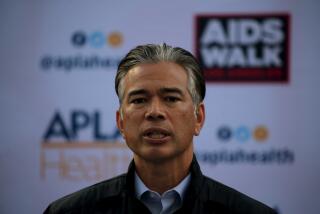Coalitions Enter Fray Over Health Care Costs : Insurance: About 1,000 O.C. firms without coverage for workers or those wanting to cut premiums may band for purchasing clout.
COSTA MESA — For years, caterer and restaurateur Hal Rosoff tried unsuccessfully to serve up a healthy menu of medical benefits to his workers.
But ever-rising health insurance premiums quoted for his 60 employees continue to scare off the owner of the Back Bay Rowing & Running Club, a trendy eatery at South Coast Plaza.
“It’s not that I don’t care,” Rosoff said. “But there is absolutely no way I can afford health insurance for them. It’s like a bottomless pit. I’d be broke.”
That could all change soon.
Rosoff plans to join a coalition of as many as 1,000 other Orange County businesses that either don’t offer health coverage for employees or want to reduce their current health care costs.
The Industrial League of Orange County has proposed a health care coalition to negotiate--much like large companies now do--with health care providers, such as health maintenance organizations or independent physician groups, to obtain discounted premiums for employers, many of whom don’t have a large enough work force to demand lower rates.
“It’s all about clout,” said Gregory S. Bishop, a health care consultant in Irvine who is heading up the project. “Alone, many of these companies can’t afford insurance. But together they have a better negotiating position.”
The coalition idea is the latest example of market-driven reforms in health care. Across the nation, businesses impatient with federal reform efforts have discovered that employer-organized organizations help hold down costs without relying on government assistance.
Companies in Detroit, Miami, Cleveland, San Francisco and Denver have already found success with such purchasing groups, which aid in cutting an average 20% from their health costs in return for membership fees to cover administrative costs. The Denver coalition, for instance, has a $2-million annual budget while the Detroit coalition has an annual budget below $1 million.
As the Clinton Administration struggles to change the way Americans receive health care, experts say that a growing number of companies, from small grocery stores to Detroit’s Big Three auto makers, are rethinking how they pay for it.
“It’s happening everywhere,” said Jim Kenney, president of the Detroit Area Health Council and chairman of the Washington-based National Business Coalition Forum on Health, which represents 140 coalitions.
Theoretically, smaller companies benefit from coalitions by piggybacking on the buying power of larger coalition members, offering their employees the same types of coverage that workers at big businesses enjoy.
For example, Fluor Corp. in Irvine, with 28,000 employees worldwide, offers a choice of 15 HMOs. Workers there pay relatively little for a wide range of health coverage, and three “indemnity” plans, in which members can select their own doctors but must pay as much as 30% for doctor visits and medical treatment after paying an annual deductible of up to $2,000.
With a coalition, employees priced out of the system for years, such as those at the Back Bay Rowing & Running Club, could be offered similar health care choices for the same per-employee cost as Fluor if both were coalition partners.
*
In Orange County, companies spend an average of $4,367 per employee for medical insurance. That compares to a state average of $4,288 and $3,938 nationwide.
Although the rate of health care cost increases in Orange County has slowed, thanks in part to greater HMO usage, Orange County remains one of the most expensive areas in the United States, said Michael Fox, who runs the Costa Mesa office of benefits consultant Foster Higgins & Co.
“Cooperatives have the potential to be very effective,” Fox said.
Such mega-purchasing groups are being examined closely because they will help determine whether managed competition--one of several reforms being considered by the Clinton Administration--actually works.
Managed competition programs require employers to be grouped under what are called Health Insurance Purchasing Cooperatives, or HIPCs. These cooperatives would act much the same as privately organized coalitions.
A new California law began Thursday that gives companies with fewer than 50 employees access to discounted insurance through the Health Insurance Purchasing Cooperative. Many health care experts and business leaders question the program’s effectiveness because the new statewide purchasing cooperative is composed of 18 insurance carriers, not employers.
In effect, insurance carriers will still determine the cost of health care.
Kenney of the coalition organization said that until employers take more control over how much they pay, health care costs will continue to rise.
“As employers, we are moving from payers of care to buyers of care,” Kenney said. “That’s a big difference in perspective. Purchasers need to have more to say over the health care they buy than they ever have before.”
National health care reforms being discussed won’t address how well patients are treated, but how the care is paid for, said Alan Hoops, chief executive of PacifiCare Health Systems, the Cypress-based HMO.
“It really should be called ‘health purchaser reform’ as opposed to health care reform,” he said.
The push for reform has led providers to rethink their competitive positions. Last week, Blue Shield of California of San Francisco and Burbank-based UniHealth America, which owns a controlling interest in PacifiCare, announced plans to merge. The resulting company would offer about 4.5 million customers in California a wide choice in health plans.
But the drive by employers to reduce their health care costs appears to be working, by some estimates. Small-business owners in coalitions have seen health care costs drop by as much as 40%, said Wendy Crimp, a health-industry consultant with accountant Kenneth Leventhal & Co. in Los Angeles.
Not all savings are that dramatic, but companies with no health benefits may be persuaded to sign up, considering the savings, she said.
“These (coalitions) could be leading players in the future of health care, whatever the Administration does,” Crimp said.
Nonetheless, Foster Higgins and other medical industry observers expressed some reservations about coalitions’ ability to draw in large numbers of uninsured workers.
With more than two-thirds of the nation’s 36 million uninsured holding down at least part-time jobs, some experts caution that coalitions will likely attract mostly companies that already provide benefits.
In other words, restaurateur Rosoff may be more the exception than the rule.
There is no exact data available on how many workers once uninsured now have coverage under existing coalitions.
Further, there are no assurances--as there would likely be under federal reforms--that coalition members will remain in the cooperative over time. Any loss of members could result in price increases for those remaining companies.
As such, coalitions do not adequately address the wider issue of inequality in the American health care system, said Sid Wolfe, head of Public Citizen, the Washington-based consumer advocacy group co-founded by Ralph Nader.
In a derisive reference to a national managed competition system, Wolfe said that “mangled competition can never work.”
*
Whether they are called coalitions, purchasing cooperatives or Health Insurance Purchasing Cooperatives, Wolf said such groups ultimately rob employees of choice over the sort of health care they need and want.
A permanent solution would only come under a single-payer system, in which all health care is open to all Americans, not just to those who are fortunate to be employed by generous companies.
“There are a lot of those who are unemployable who don’t ever make it into coalitions,” Wolfe said. “What about them?” The plan would be paid for, according to one Clinton proposal, by a 7% corporate tax and a 2% to 3% tax on all workers’ salaries.
Coalition supporters argue that unified insurance purchases are still a valuable component to reforming health care.
John Sforza, president of the Florida Health Coalition in Miami, said that negotiating discounts is only one role of a coalition.
Sforza’s 7-year-old group, which is part of a larger, statewide Employers Purchasing Alliance, works to ensure that workers continue to receive high-quality care without paying for unnecessary X-rays, blood tests or other diagnostic treatments. Individual companies too often don’t have the time or resources for such scrutiny.
Controlling costs that way could mean a windfall for the Florida alliance, which has a goal of cutting members’ health care costs by about $100 million, or roughly 20%, by the end of the summer.
With nearly 1.4 million members, this is the largest such organization in the country. Members include large employers including Dade County, with 25,000 employees, and the utility company Florida Power & Light, with 17,000 workers.
Sforza said that his coalition recently created low-cost mental health and alcohol- and drug-abuse programs for its members, which is expected to save more than $2 million over more-expensive programs.
“We can put the pieces together, where our members may not be able to separately,” Sforza said.
In Orange County, Bishop said that he and other members of his fledgling group will spend the next four to six months studying existing organizations. Issues to be examined include how the proposed coalition would contract with providers, who would oversee it and how its operations would be funded.
It is too early to gauge local employer interest, though Bishop said that he and others will go from company to company to drum up support.
One potential member is the Irvine aerospace division of Cleveland-based Parker Hannifin Corp.
Joyce Muncell, the company’s local manager of health care resources, said Parker Hannifin, which contracts with a variety of independent physicians groups and local hospitals for medical benefits, is looking into joining the group.
The company now contracts with four independent physicians groups associated with St. Jude Medical Center in Fullerton; St. Joseph Hospital, Orange; Saddleback Memorial Medical Center, Laguna Hills; and Hoag Hospital in Newport Beach.
Before deciding, Muncell’s department wants to determine whether Parker Hannifin’s headquarters benefits from a recently formed coalition--the Cleveland Quality Choice Project.
Tom Rose, director of medical benefits for the Ohio facility, said the company has been involved for three years in forming the coalition. By year’s end, he expects to save as much as 20% on employee health care.
“There is a lot of interest,” Muncell said, adding that she will wait to see the local coalition’s plan to decide whether it is best for her division. “This is a complex (health care) market.”
Employers Purchasing Alliance at a Glance
One of the first grass-roots employer coalitions. Offers flexible group-purchased health coverage through both HMO and preferred-provider networks.
* Established: 1979
* Headquarters: Miami
* Number of employers: 35
* People covered: 1.4 million
* Administrative employees: 50
* Goals: To increase group-purchasing contracts and membership. Working with state of Florida to develop a database for use in evaluating and improving quality of health care.
* Specialized services: Conducts seminars to help individual employers manage health care costs effectively. Audits claims and lobbies on behalf of legislation aimed at health care reform and access to health care data.
* Largest companies covered: Florida Power & Light, Ryder Systems.
Source: Employers Business Coalition; Employers Purchasing Alliance;
Researched by JANICE L. JONES / Los Angeles Times
More to Read
Inside the business of entertainment
The Wide Shot brings you news, analysis and insights on everything from streaming wars to production — and what it all means for the future.
You may occasionally receive promotional content from the Los Angeles Times.










